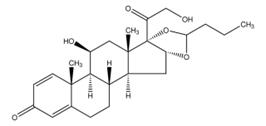INTRODUCTION
Budesonide is in a class of medications called corticosteroids. It works by decreasing inflammation (swelling) in the digestive tract of people who have Crohn’s disease or ulcerative colitis. or in the kidney of people with nephropathy.
MANUFACTURE
It is manufactured by the reaction of 16α-hydroxyprednisolone (11β,16α,17α,21-tetrahydroxypregna-1,4-diene-3,20-dione) with butyraldehyde in dioxane, using perchloric acid as catalyst.
| Synonym | 16,17-Butylidenebis(oxy)-11,21-dihydroxypregna-1,4-diene-3,20-dione |
| CAS no. | 51333-22-3 |
| EINECS no. | 257-161-7 |
| Molecular formula | C25H34O6 |
| Molecular weight | 430.5 g/mol |
| Structure |  |
APPLICATIONS
| It is used for the treatment of: |
|---|
| Asthma |
| Inflammatory bowel disease |
| Allergic rhinitis |
| Eosinophilic esophagitis |
| Berger’s disease |
SPECIFICATIONS… (EP)
| Test | Unit | Specification |
|---|---|---|
| Appearance | – | White or almost white, crystalline powder. |
| Solubility | – | Practically insoluble in water, Freely soluble in methylene chloride, sparingly soluble in alcohol (96%). |
| Identification | ||
| A) By IR Absorption | – | The IR spectrum of the sample should be concordant with that of a similar preparation of Budesonide standard. |
| B) By TLC | – | The principal spot of the test chromatogram should correspond to the principal spot of reference solution (a) at 254nm and 365nm. |
| C) By Chemical | – | The colour should fade and a clear solution remains. |
| D) By Chemical | – | The solution should turn blue. |
| Loss on drying | % | Not more than 0.5 |
| Epimer A (Second Peak) | % | 40.0 to 51.0 |
| Related Substances (By HPLC) | ||
| Impurity A | % | Not more than 0.2 |
| Impurity D | % | Not more than 0.2 |
| Impurity K | % | Not more than 0.2 |
| Impurity L | % | Not more than 0.2 |
| Unspecified impurities | % | Not more than 0.10 |
| Total impurities | % | Not more than 0.5 |
| Assay (By HPLC) (on dried substance) | % w/w | 97.5 to 102.0 |
| Residual Solvents | ||
| Methanol | ppm | Not more than 1000 |
| Dichloro Methane | ppm | Not more than 600 |
| n-butyraldehyde | ppm | Not more than 150 |
| Benzene | ppm | Not more than 2 |
| Dimethyl formamide | ppm | Not more than 880 |
PACKING
Fiber/HDPE drum.
STORAGE
Store in cool place. Keep container tightly closed in a dry and well-ventilated place.
CERTIFICATION
WHO–GMP, Written Confirmation for EU and CEP.
No matter the quantity you need, our exceptional quality and service will make ExSyn your supplier of choice! If you need any additional information or SDS, please contact us.
5-Methyl-3-vinyl-2-oxazolidinone (V-MOX) is a highly reactive monomer valued for its low viscosity, mild odor, and excellent reactivity. It is widely used as a reactive diluent in UV-curable inks and coatings, where it enhances adhesion, produces brighter colors, and improves safety compared to conventional diluents. In addition, V-MOX serves as a key building block in the synthesis of kinetic hydrate inhibitor (KHI) polymers, which are applied in oil and gas production to prevent hydrate blockages in pipelines.
Zinc ricinoleate is the zinc salt of ricinoleic acid, a hydroxylated fatty acid derived mainly from castor oil (Ricinus communis). It appears as a white to slightly yellowish powder, waxy solid, or paste, depending on formulation. Its most valuable property is its ability to trap and absorb odor molecules such as amines, sulfides, and short-chain fatty acids, making it an essential ingredient in deodorant and odor-control products.
2-(tert-Butyl amino)ethyl methacrylate (TBAEMA) is a functional methacrylate monomer that contains a secondary amine group and a hydrophobic tert-butyl moiety, giving it excellent versatility in pH-responsive and adhesion-enhancing polymer systems.
It is valued in printing ink formulations for its ability to enhance adhesion, flexibility, and surface interaction.
Commonly known as potassium bis(fluorosulfonyl)imide (KFSI), the compound has a three-carbon backbone bearing six fluorine atoms and two sulfonimide (-SO₂F) groups. The molecule’s architecture lends it both high chemical stability and useful reactivity. Because of its excellent ionic conductivity and thermal / electrochemical stability, it finds use in advanced electrolyte formulations—for example in lithium-ion and next-generation batteries, in ionic liquids, and in other electrochemical systems.
Colchicine is a naturally occurring alkaloid obtained primarily from the autumn crocus (Colchicum autumnale) and related species. It has been used in medicine for centuries, especially for the treatment of gout and Familial Mediterranean Fever. In modern medicine, Colchicine is valued also in conditions like pericarditis, Behçet’s disease, and certain dermatological and cardiac disorders.
1-Butylimidazole is a versatile organic heterocyclic compound belonging to the imidazole family, where a butyl group (–CH₂–CH₂–CH₂–CH₃) is attached to the nitrogen atom at the 1-position of the imidazole ring. Its applications span organic synthesis, materials science, and bioactive compound development due to its tunable physicochemical properties and structural versatility.
Atropine sulfate monohydrate is a chemical compound, specifically a salt of atropine and sulfuric acid, with one water molecule (monohydrate) attached. It is commonly used as a medication and in research due to its anticholinergic properties, meaning it blocks the effects of acetylcholine at muscarinic receptors.
4-Aminobenzoic acid, commonly abbreviated as PABA, is an aromatic amine and carboxylic acid compound. It consists of a benzene ring substituted with an amino group (–NH₂) in the para position to a carboxylic acid group (–COOH).
2-Amino-5-Nitrophenol (5-NAP) is an organic compound with the molecular formula C₆H₆N₂O₃. It is a substituted phenol with both an amino group (-NH₂) and a nitro group (-NO₂) attached to a benzene ring, along with a hydroxyl group (-OH).
